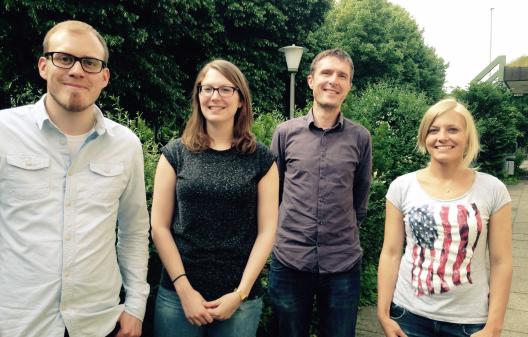How does the nervous system develop?
With their long processes - the axons and dendrites - nerve cells connect with each other and thus pass on signals. These connections can degenerate – not only in the case of diseases of the nervous system, but also when an organism develops normally. But what are the mechanisms behind this? Researchers at the Cells-in-Motion Cluster of Excellence have now discovered a physiological process which plays an important role in the degeneration of neuron cell processes. It was found that the PAR-1 protein drives a series of consecutive signals which eventually result in the disassembly of the cytoskeleton. The study is published in the current issue of “Embo Journal”.
Many of the connections between nerve cells disappear again during development because they have failed to develop a specific function. In the process, the axons and dendrites that the nerve cells used to link up retract again. Scientists call this process pruning. “Pruning is an interesting mechanism in development which is not yet well understood,” says biologist Dr. Sebastian Rumpf. At the Cluster of Excellence, Sebastian Rumpf heads a junior research team who have specialized in studying this process in the fruit fly Drosophila melanogaster. “We are looking at a type of nerve cell that specifically loses all its dendrites during the development,” explains Svende Herzmann, the lead author of the study and a PhD student at the Graduate School of the Cluster of Excellence.
It was known for some years that components of the cytoskeleton are lost before dendrites break down. These are the tubular microtubules which stabilize the cells and dendrites. Sebastian Rumpf and his team have now discovered what complex mechanisms are behind the breakdown of these microtubules. To this end, they analysed genetic mutations: in the nerve cells of fruit flies which lacked PAR-1, the microtubules remained stable. They further found that PAR-1 reduces the activity of a protein called tau which binds to the microtubules and holds them together. If the tau protein is less active, a microtubule-severing enzyme can “strike” and the microtubules break down.

Using live cell imaging, the researchers showed that these processes occur in the early pupal phase of the fruit flies. “While the larvae still had stable dendrites, we were already able to observe clear gaps in the cytoskeleton,” says Svende Herzmann. The disappearance of the microtubules ultimately caused the dendritic cell processes to degenerate.
The PAR-1 and tau proteins had already previously been linked in the context of neurodegenerative diseases such as Alzheimer’s. However, what relevance this link has in a healthy organism had not been clear up to now.
After the cytoskeleton had been destroyed by PAR-1, the cell processes became thin very quickly and their membrane became fragile. “We think there’s a direct connection between the stabilizing microtubules and the cell membrane,” says Sebastian Rumpf. “Now that we understand the signalling process and the mechanisms behind the breakdown of the microtubules, we’ve taken a big step forward when we analyse the disappearance of the nerve linkages,” he adds. Ultimately, the results of this basic research should help the researchers to have a better understanding of the development of the nervous system. It cannot yet be stated whether there are any short-term applications for these findings. “But,” says Sebastian Rumpf, “it’s interesting that these proteins play a role in both the physiological and the pathological disassembly of nerve linkages.”
Original publication:
Herzmann S, Krumkamp R, Rode S, Kintrup C, Rumpf S. PAR-1 Promotes Microtubule Breakdown During Dendrite Pruning in Drosophila. EMBO J 2017; DOI: 10.15252/embj.201695890 Abstract

Background:
The junior research group “Developmental Neurodegeneration”, headed by Dr. Sebastian Rumpf, has been in existence at the Cells-in-Motion Cluster of Excellence since late 2013. The study is the first joint publication to come from the team of researchers.

